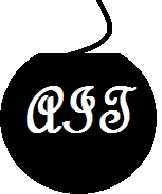CLASSIFICATION OF STEAM TURBINE
1.) According to the direction of steam flow
1.Axial turbine: in which the steam flows in a direction parallel to the axis of turbine.
2.Radial turbine: in which the steam flows in a direction perpendicular to the axis of the turbine.
2.) According to number of cylinders
1.Single cylinder turbine.
2.Double cylinder turbine.
3.Three cylinder turbine.
4.Four cylinder turbine.
3.) According to the method of governing
1.Throttle governing. 2. Nozzle governing.
3.By pass governing.
4.) According to the principle of action of steam
1.Impulse turbine.
2.Reaction turbine.
5.) According to the Heat balance arrangements (Based on Inlet & Outlet Steam Condition)
1.Condensing turbines:- Full steam quantities entering into the turbine are exhausted, and converted to condensate in a condenser. The exhaust steam pressure is lower than the atmospheric pressure.
2.condensing with extraction turbines:- Medium or low pressure steam required by the process plant is extracted from the intermediate stage of a condensing or back pressure turbine.
3.Back pressure turbines:- The Exhaust steam from the turbine flows out of the steam piping at medium or low pressure. Basically, the exhaust steam can be used effectively in any other machines or equipment in the plant.
4.Topping turbines
5.Low pressure (Exhaust pressure ) turbines
6.) According to the steam inlet conditions
1.Low pressure turbines (1.2 ata to 2.0 ata)
2.Medium pressure turbines (up to 40 ata)
3.High pressure turbines (40 ata to 170 ata)
4.Very high pressure turbines (pressure & temp Above 170 ata & 550 deg c)
5.Supercritical pressure turbines ( above 225 ata)
7.) According to the steam inlet conditions
1.Tandem compound turbines
2. cross compound turbines
Impulse & Reaction Turbine (Based On Blade Design)
A.) Definition of Impulse and Reaction Turbine
1.) Impulse turbine
IMPULSE TURBINE = In a stage of Impulse turbine the pressure/ Enthalpy drop takes place only in Fixed blades and not in the moving blades.
There is no pressure drop across moving blades. Steam energy is transferred to the rotor entirely by the steam jets striking the moving blades. Since there is no pressure drop, negligible thrust is produced.
An impulse turbine uses the impact force of the steam jet on the blades to turn the shaft. Steam expands as it passes through the nozzles, where its pressure drops and its velocity increases. As the steam flows through the moving blades, its pressure remains the same, but its velocity decreases. The steam does not expand as it flows through the moving blades.
2.Reaction turbine
REACTION TURBINE = In a stage of Reaction Turbine the Pressure/enthalpy drop takes place in both the fixed and moving blades.
Steam expands in both the stationary & moving blades. Moving blades also act as nozzles. High axial thrust is produced.
In the reaction turbine, the rotor blades themselves are arranged to form convergent nozzles. This type of turbine makes use of the reaction force produced as the steam accelerates through the nozzles formed by the rotor.
3.) Combination of Impulse & Reaction turbine
Impulse-reaction:
In reaction the pressure is reduced in both fixed and moving blades. Both fixed and moving blades acts like nozzles. Work is done by both impulse and reaction effect.
- DEGREE OF REACTION= Heat drop in Moving stage) /( Heat drop in moving blade + Heat drop in fixed blade)
- In impulse stage ,degree of reaction is O
- Single stage impulse turbine is called as De-laval Turbine.
- Series of impulse stages is called as Rateau Turbine
- Double Stage Velocity Compounded impulse turbine is called as Curtis Stages
- 50% Reaction turbine is called as Parson Turbine
- Practically the degree of reaction of a stage can be 0 – 60% over the different stages of a turbine.






